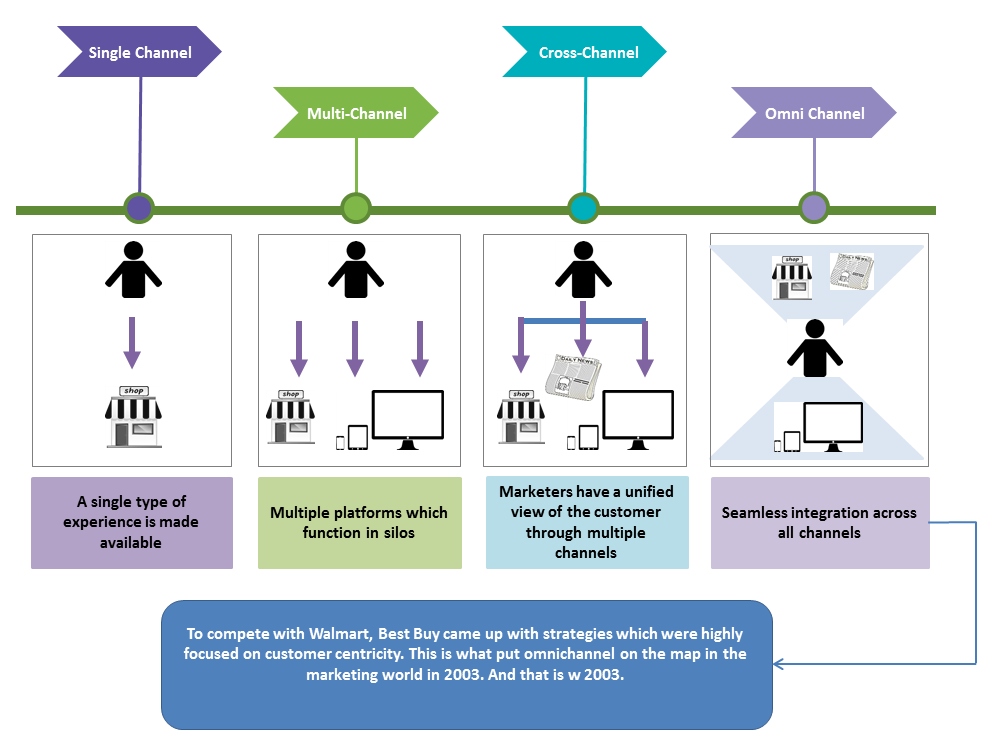
Omni channel Advertising – a Boon or Multi-Faceted Challenge?


‘Omnichannel’ as a term or concept has been on an uptrend in the retail industry for the last few years. There are various interpretations of the concept, some rightly perceived and some confused.
Omnichannel advertising aids in driving users down the purchase funnel, but it has not proved to be right in many cases. This is mainly because the basic understanding of an omnichannel is not strong and it is often confused with cross-channel or multi-channel strategies.
An omnichannel is an intersection of all strategies, creating an integrated, ongoing, seamless experience for customers. Marketers are trying various ways to keep pace with customer needs, such as increasing investments in technology and integrating shopping experiences. However, are these strategies hitting the bull’s-eye? An understanding of the gaps, relaying strategies with the help of the right analytics, optimal use of customer data, and keeping pace with evolving trends will help achieve goals at various levels.
After multi-channel marketing and cross-channel selling, the omnichannel approach created a buzz in the retail industry. There have been various interpretations of the approach, with some defining it as an efficient execution of a cross-channel strategy or multi-channel marketing done well, etc. Omni means ‘in all ways or places.’ In marketing terms, omnichannel is perceived as something that provides a continual or ongoing customer experience.
Omnichannel vs. Multi-channel
A multi-channel advertising approach involves the usage of various modes or platforms to reach out to the target audience. These include physical stores, websites, mobile apps, promotional events, emails, etc. on a desktop, laptop, mobile phone, or tablet. Omnichannel is more about integrating the experience across these various channels. Customers can transact using any or all of these channels, but the experience rendered should be seamless. Cross-channel refers to mixing channels to help consumers have a seamless shopping experience. For example, a consumer could use a newspaper coupon or an email coupon during a store or an online purchase.
An omnichannel helps break the barriers between the online and offline channels and allows the customer to experience the brand per their will and convenience.
How Did It Evolve?

An omnichannel service and experience should be able to provide service wherever, whenever, and however customers want, and this expectation is common across all business verticals.
Finance & Banking:
- With the advent of digital banking, Omnichannel came to the finance and banking sector.
- Transactions through ATMs, the Internet, mobile apps, etc., paved the way for channel integration, advertising for other channels, personalized options and offers. Banks are able to understand their customers better, and enhance relationships and profitability.
Healthcare:
- Digital technology has brought about huge changes in the healthcare world.
- The omnichannel experience is created through methods such as digital treatments, fixing appointments online, use of sensors to track health movements remotely, genomics, wearables, etc.
- However, most health systems and pharmaceutical brands are struggling to create the perfect omnichannel experience, due to the presence of various channels and touch points.
Retail:
- Strategies are redesigned to align with the digital world, such as social media, mobile, tablets, etc.
- Experiences are connected across all touch points. For instance, customers can look at a product offering at a brick and mortar store, browse using their mobile applications for additional information, offers, or reviews, and make an actual purchase from home using their laptop. Either the order is delivered to their doorstep, or the customer chooses to pick it up from a collection point. The shopping journey is continuous across all touch points.
Government:
- Government organizations began using Twitter in 2009 to interact with citizens.
- Twitter is used to route all communications to people, who could absorb it at their convenience. It serves as a forum to share feedback, suggestions, and reviews on different aspects of citizens’ experiences regarding the government.
Business to Business:
- Companies running various businesses are increasing the number of channels which customers can use to reach out to them for any support or assistance, such as email, chat, SMS, social media, telephone, etc.
- In recent times, use of a technology named Aspect System provides an assistance solution which routes calls to personnel based on the required skills, knowledge, and continuity that is expected by the customer.
- For example, customers should be allowed to move seamlessly from a chat session to a phone call, and be able to connect to the same agent without having to repeat the issue each time.
The Biggest Challenges Encountered by Marketers While Implementing Omnichannel Strategies
- Keeping pace with the increasing expectations of consumers
Customers always pose the biggest challenge to marketers. Each individual has varied expectations and a unique behavioral pattern. Their needs or expectations are subject to rapid change over time. On the other side, the evolution of technology is so quick in the digital world that marketers often face hurdles balancing the two. To meet increasing customer expectations, marketers are occasionally required to innovate and invest in upgrading their capabilities. This is likely to have a large impact on marketing budgets, as the expenditure involved in purchasing the latest technology and acquiring the right skills is high.
- Poor data quality: lack of efficient customer analytics
Ensuring a seamless omnichannel experience has become vitally important in all kinds of businesses, as consumers these days are likely to make purchases using any available channel.
Good data forms an important base in any marketer’s omnichannel strategy. The number of avenues available for data collection is large, as many brands lay out channels to their customers. The amount of data collected through each medium is humungous. However, the question is, how much of these data are organized? Is the collation of the data well-coordinated? The answer is that many businesses have yet to streamline their processes to manage their data efficiently. The right use of customer data can help brands build campaigns that resonate with their target audience. This is possible only if brands are able to understand the various patterns of their customer expectations, usage, attitudes towards the brand, etc. Haphazard data can lead to a waste of resources and prospects. Decisions and strategies based on poor-quality data may result in losses for marketers and will not support any form of customer analytics.
- Customer engagement across channels
Retailers understand that loyal customers are the key to their success. Research has proven that 67 percent of repeat customers spend more than newly acquired ones. Due to a lack of connection with their experience, 65–80 percent of customers do not come back, underlining the view that good products or services alone cannot keep a customer’s loyalty. The first step to addressing this will be to understand omnichannel buyer behavior and shopping journey across channels. The second step will be to deploy an appropriate strategy to address buyers’ requirements that ensures consistent experience on any channel they may use.
What Should Marketers Focus on to Deliver a Good Omnichannel Experience?
Despite the challenges, how can marketers improve upon their omnichannel strategies?
- Mitigating the gaps between the physical and the digital worlds:
A seamless customer experience and increased sales opportunities can be achieved by bridging the gap between the online and offline journey of the consumer. This can be achieved by ensuring the same brand experience across all touch points that interface with the consumer: digital marketing, in-store, mobile apps, email marketing, social media, and other channels. Marketers should understand the impact of each channel or message on the others and ensure consistency among their different channels. For instance, an apparel brand advertises for its upcoming seasonal sale on social media by offering codes to unlock discounts on purchases. The email addresses of potential or prospective customers can be collected by a click made by consumers when accessing the campaign. This way, target messaging can be applied to reinforce the social media campaign and route customers to either stores or online portals.
- Customer-centric strategy:
Identify the right avenues and invest in strategies unique to the business that can help strengthen the customer’s path to purchase and overall brand experience. In coming years, there will not be a channel that is necessarily better to sell on than others. It will be about being in the right marketplaces with the right strategies for your target customers. Placing customers and their needs at the center of your business strategy is crucial for market success.
- Use of data analytics to drive applicable insights:
Analysis of customer data paves the way for opportunities to personalize targeting and communication, creating more possibilities for upselling and increased customer loyalty. To ensure informed decision-making, strong support from advanced supply chain and inventory analytics will help achieve efficiency and profitability.
- Support of management with a clear vision:
The entire organization, from the top down, should be aligned with its business vision and adopt the omnichannel culture. Omnichannel experiences can be very complex. Most organizations focus too much on the technology required to assist in transformation, leaving out one of the most important variables—people. The organizations that have seen the most success place the customer at the center of every business decision they make, from the CEO on down the hierarchy. They align their technology around that strategy, which is shared throughout the organization. Changes in technology alone will not solve the omnichannel problem; the alignment must be at a 360-degree level.
Conclusion
Omnichannel shopping is becoming the new norm for customers across the globe. Modern consumers are informed, interconnected, and impatient. They are familiar with new technologies and prefer convenient and seamless shopping experiences. On the other side, they are also very demanding, expecting complete flexibility across channels, and are ready to reward retailers that can provide these experiences with their loyalty.
Although the road to omnichannel retailing seems challenging, all retailers should consider this a transformation process, as it will be one of the most efficient ways to succeed in the ever-changing market. The most important step towards omnichannel retailing involves eliminating the silos that separate the operations of different channels and integrating disparate systems, databases, and processes. Thus, retailers should aim to integrate on one omnichannel platform that can facilitate data exchange and allow for smooth functioning of their processes. Such integration, backed by analytics, will provide an opportunity to create a full view of the customer’s journey and provide complete visibility across channels, enhancing the customer experience and optimizing operations.
References
- https://www.marketingtechnews.net/news/2017/jan/26/how-omnichannel-marketing-makes-siloed-advertising-channels-thing-past/
- https://www.digitalistmag.com/customer-experience/2017/11/24/change-management-overcoming-challenges-of-implementing-omnichannel-strategy-05534744
- https://www.bigcommerce.com/blog/omni-channel-retail/
- https://www.magestore.com/what-is-omnichannel-retail
- https://www.shopify.com/enterprise/10-best-omni-channel-retailers-and-what-you-can-learn-from-them
- https://www.businesstoday.in/current/economy-politics/retail-30-the-emergence-of-the-omni-channel-in-2017/story/267055.html
Related Insights:
View All
Get more stories like this
Subscirbe for more news,updates and insights from Beroe






